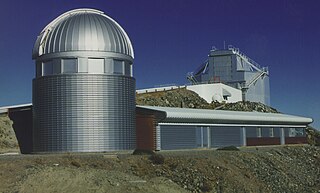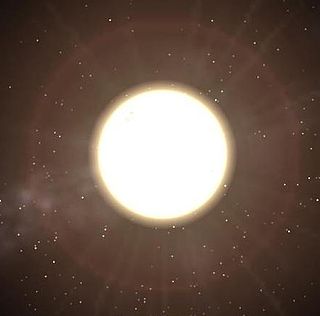Related Research Articles
HD 82943 is a yellow dwarf star approximately 89 light-years away in the constellation of Hydra. Two extrasolar planets have been confirmed to be orbiting it, and it is thought that the system had more giant planets that were "swallowed" by the parent star. HD 82943 is estimated at 1.15 times the mass of the Sun.
HD 169830 is a star in the southern constellation of Sagittarius. It has a yellow-white hue and is dimly visible to the naked eye with an apparent visual magnitude of +5.90. The star is located at a distance of 120 light years from the Sun based on parallax. It is drifting closer with a radial velocity of −17.3 km/s, and is predicted to come as close as 20.7 ly (6.4 pc) in 2.08 million years. HD 169830 is known to be orbited by two large Jupiter-like exoplanets.
HD 28185 is a yellow dwarf star similar to the Sun located 128 light-years away from Earth in the constellation Eridanus. The designation HD 28185 refers to its entry in the Henry Draper catalogue. The star is known to possess one long-period extrasolar planet.
HD 1237 is a binary star system approximately 57 light-years away in the constellation of Hydrus.

HD 28185 b is an extrasolar planet 128 light-years away from Earth in the constellation of Eridanus. The planet was discovered orbiting the Sun-like star HD 28185 in April 2001 as a part of the CORALIE survey for southern extrasolar planets, and its existence was independently confirmed by the Magellan Planet Search Survey in 2008. HD 28185 b orbits its sun in a circular orbit that is at the inner edge of its star's habitable zone.
HD 169830 b is an extrasolar planet three times the mass of Jupiter. Due to its high mass, it is most likely a gas giant planet, akin to Jupiter and Saturn in the Solar System. This planet at 0.8 AU is slightly farther out than Venus is in the Solar System, orbiting around its star every 262 days.
HD 213240 b is an exoplanet located 134 light-years from the Solar System in the constellation of Grus. It is a gas giant orbiting the G-type star HD 213240.
HD 45652 b, also named Viriato, is a gas giant extrasolar planet orbiting at only 0.23 AU from the star HD 45652, with an orbital period of 44 days. It has mass at least half that of Jupiter. As it was detected using the radial velocity method, its true mass is dependent on the inclination of its orbit; if it is low, then the true mass will be larger. Also, its radius is not known. This planet was discovered by measurements taken by the ELODIE spectrograph from 2005 and 2006, and later confirmed by CORALIE and SOPHIE between 2006 and 2007. The discovery was announced in May 2008.

Leonhard Euler Telescope, or the Swiss EULER Telescope, is a national, fully automatic 1.2-metre (47 in) reflecting telescope, built and operated by the Geneva Observatory. It is located at an altitude of 2,375 m (7,792 ft) at ESO's La Silla Observatory site in the Chilean Norte Chico region, about 460 kilometers north of Santiago de Chile. The telescope, which saw its first light on 12 April 1998, is named after Swiss mathematician Leonhard Paul Euler.
HD 30562 b is an extrasolar planet which orbits the F-type main sequence star HD 30562, located approximately 85.4 light years away in the constellation Eridanus.
HD 171238 b is an extrasolar planet which orbits the G-type main sequence star HD 171238, located approximately 164 light years away in the constellation Sagittarius. This planet has minimum mass two and a half times greater than Jupiter and orbits two times closer to the star than Jupiter to the Sun. However this planet orbits in an eccentric orbit, about two astronomical units difference between periastron and apastron distances. This planet was discovered in August 2009 by using the radial velocity method in La Silla Observatory, Chile.

The Magellan Planet Search Program is a ground-based search for extrasolar planets that makes use of the radial velocity method. It began gathering data in December 2002 using the MIKE echelle spectrograph mounted on the 6.5m Magellan II "Clay" telescope located within the Las Campanas Observatory in Chile. In 2010, the program began using the newly commissioned Planet Finder Spectrograph (PFS), an instrument purpose-built for precise radial velocity measurement.
HD 86226 is a G-type yellowish white star found in the constellation of Hydra.

HD 129445 is a G-type star found in the Circinus constellation located 219 light-years away from the Sun based on parallax. It is invisible to the naked eye with an apparent visual magnitude of 8.80. The star was observed by the Magellan Planet Search Program due to its absolute visual magnitude and high metallicity. The Magellan program conducted 17 doppler velocity measurements, which spans a full orbital period. The results led the program to detect a planet dubbed HD 129445 b. In 2023, the inclination and true mass of HD 129445 b were determined via astrometry.
HD 129445 b is an eccentric Jupiter gas giant exoplanet orbiting the star HD 129445 which was discovered by the Magellan Planet Search Program in 2010. Its minimum mass is 1.6 times Jupiter's, and it takes 5 years to complete one orbit around HD 129445, a G-type star approximately 219 light years away. In 2023, the inclination and true mass of HD 129445 b were determined via astrometry.
HD 152079 is a star in the constellation Ara.
HD 164604 is a single star in the southern constellation of Sagittarius constellation. It has the proper name Pincoya, as selected in the NameExoWorlds campaign by Chile, during the 100th anniversary of the IAU. Pincoya is a female water spirit from southern Chilean mythology who is said to bring drowned sailors to the Caleuche so that they can live in the afterlife. A 2015 survey ruled out the existence of any additional stellar companions at projected distances from 13 to 340 astronomical units. It is known to host a single super-Jupiter exoplanet.
HD 164604 b is an extrasolar planet discovered in January 2010 in association with the Magellan Planet Search Program. It has a minimum mass 2.7 times the mass of Jupiter and an orbital period of 606.4 days. Its star is classified as a K2 V dwarf and is roughly 124 light-years away from Earth.
HD 175167 is a star with an exoplanet companion in the southern constellation of Pavo. It is too faint to be visible with the naked eye at an apparent visual magnitude of 8.01. The system is located at a distance of 232 light-years from the Sun based on parallax measurements, and it is drifting further away with a radial velocity of 5 km/s. It shows a high proper motion, traversing the celestial sphere at an angular rate of 0.190 arcsec yr−1.
HD 175167 b is an exoplanet orbiting HD 175167, which is a G type star within the Pavo constellation 232 light-years away from the Earth. The planet was discovered by the Magellan Planet Search Program as the astronomical object fit the Keplerian orbital model. During the observations 13 doppler velocity tests were conducted, which showed this object's mass was at least 7.8 Jovian-masses and its orbit has a high eccentricity. The exoplanet takes 3.53 years to complete a full stellar orbit.
References
- ↑ Arriagada, P.; et al. (2010). "Five Long-period Extrasolar Planets in Eccentric orbits from the Magellan Planet Search Program". The Astrophysical Journal . 711 (2): 1229. arXiv: 1001.4093 . Bibcode:2010ApJ...711.1229A. doi:10.1088/0004-637X/711/2/1229. S2CID 118682009.
- ↑ Marmier, M.; et al. (2013). "The CORALIE survey for southern extrasolar planets XVII. New and updated long period and massive planets". Astronomy & Astrophysics . 551: A90. arXiv: 1211.6444 . Bibcode:2013A&A...551A..90M. doi:10.1051/0004-6361/201219639. S2CID 59467665.
- ↑ "Exoplanet-catalog". Exoplanet Exploration: Planets Beyond our Solar System. Retrieved 2020-01-10.
- ↑ Teske, Johanna; et al. (2020), "TESS Reveals a Short-period Sub-Neptune Sibling (HD 86226c) to a Known Long-period Giant Planet", The Astronomical Journal, 160 (2): 96, arXiv: 2007.13927 , Bibcode:2020AJ....160...96T, doi: 10.3847/1538-3881/ab9f95 , S2CID 220830943